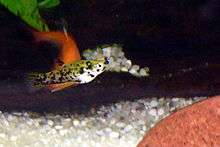Speckled mosquitofish
| Phalloceros caudimaculatus | |
|---|---|
 | |
| Scientific classification | |
| Kingdom: | Animalia |
| Phylum: | Chordata |
| Class: | Actinopterygii |
| Order: | Cyprinodontiformes |
| Family: | Poeciliidae |
| Genus: | Phalloceros |
| Species: | P. caudimaculatus |
| Binomial name | |
| Phalloceros caudimaculatus (R. F. Hensel, 1868) | |
The speckled mosquitofish or the one-spot livebearer (Phalloceros caudimaculatus) is a species of fish native eastern and southern Brazil, northern Argentina, Uruguay and Paraguay.[1] It has also been introduced to Australia, Malawi and New Zealand; primarily for mosquito control, but also as escapees from the aquarium trade.[1] It has been reported as having adverse ecological effects in areas where it has been introduced.[1] The females of this species grow to a length of 6 centimetres (2.4 in) TL.[1]
Origins
This species originated in South America.[2] It is mainly a freshwater fish and thrives best in areas with weak water flow.[2] However, it is extremely adaptable and can thrive in a multitude of altered environments.[2] For example, the mosquitofish can thrive in temperatures as low as 5°C.[2] The species also has a high fecundity.[3]
This speckled mosquito fish was one of the first in its family to be bred for aquarium usage.[2] Ecologists also attempted to use the fish as a mosquito control; however, the mosquito fish's diverse diet affected its efficacy as a control species.[2] The mosquito fish can eat a range of different organisms, including algae.[2]
Role as an invasive species
The speckled mosquitofish was introduced to a variety of ecosystems both by aquarium keepers and as mosquito pest control.[2] The NSW area of Australia has been affected the most by its presence.[2] It reproduces and spreads well in the winter when there is a larger flow of water.[2] Australian ecologists have tried to contain this spread by killing them with rotenone; however, the infestation persists.[2] The mosquitofish is most likely to be found in shallow areas with varying levels of vegetation, such as local ponds.[3]
The ecological impact of the speckled mosquitofish in Australia is pronounced. Its diet has affected populations of both native and non-native fish.[3] An example would be the non-native species Gambusia holbrooki.[3] It has similar features as the mosquito fish, such as a high reproductive rate and use for mosquito control.[3] However, its population in Australia has diminished since the introduction of the speckled mosquitofish.[3] Furthermore, this mosquitofish has also affected the food chain, as they have become prey for native bird species.[3]
References
- 1 2 3 4 Froese, R; Pauly, D (eds.). "Phalloceros caudimaculatus summary page". FishBase. Retrieved 2015-11-23.
- 1 2 3 4 5 6 7 8 9 10 11 Maddern, M.G. (2008). "Distribution and spread of the introduced One-spot Livebearer Phalloceros caudimaculatus (Pisces: Poeciliidae) in southwestern Australia" (PDF). Journal of the Royal Society of Western Australia (91): 229–235. Retrieved November 23, 2015. line feed character in
|title=at position 62 (help) - 1 2 3 4 5 6 7 Rowley, J. J. L.; Rayner, T. S.; Pyke, G. H. (2005-09-01). "New records and invasive potential of the poeciliid fish Phalloceros caudimaculatus". New Zealand Journal of Marine and Freshwater Research. 39 (5): 1013–1022. doi:10.1080/00288330.2005.9517372. ISSN 0028-8330.